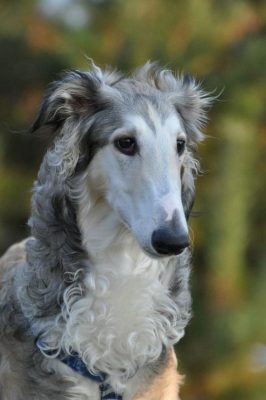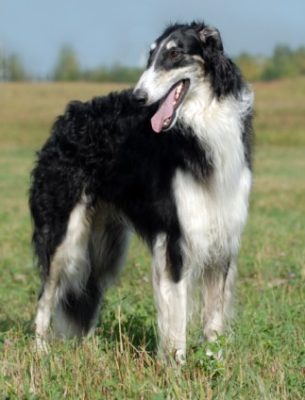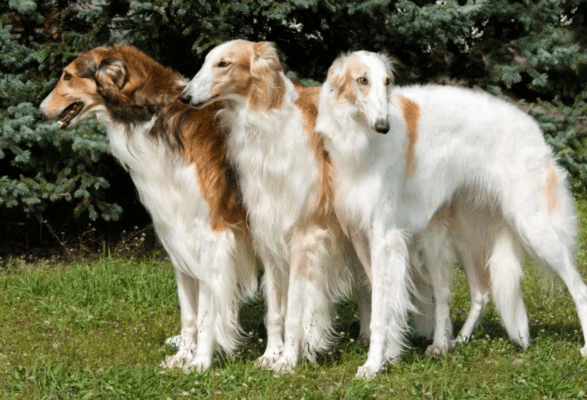Borzoi
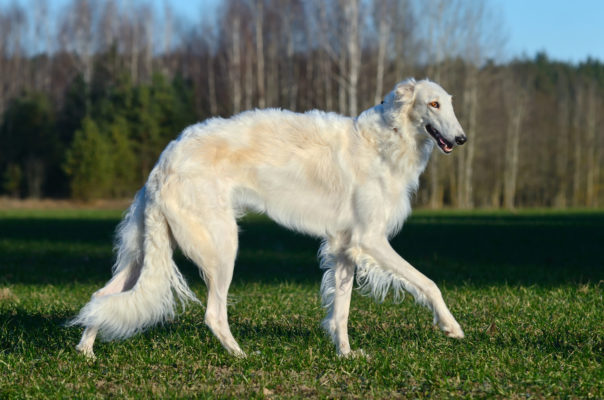
The greyhound is a sweet, intelligent dog. This breed is very loyal to its family. It is very affectionate to people it knows well. The Borzoi is a noble dog that gets along quite well with children, but it is not ideal for being a companion for a child. They can be trained in obedience.
Table of Contents
Breed Information
| Another Name | Russian Wolfhound, Russian Hunting Sighthound, Russkaya psovaya borzaya |
| Origin | Russia |
| Height | 67-79 cm |
| Weight | Males 34-47 kg Females 25-40 kg |
| Fur | Long hair |
| Color | White, red, gray |
| Lifespan | 10-12 years |
| FCI Classification | Sighthounds |
| Group | Hunting dogs |
| Price | $400-800 |
Breed Photos
Origin History
The history of the Borzoi, once known as the Russian Wolfhound, dates back to 1650 when the first standard for the breed was drawn up in its native Russia. Bred over hundreds of years by Russian nobles, the Borzoi is believed to have descended from early Borzoi, hound dogs, and high sheepdogs.
By 1873, few greyhounds remained, which alarmed those who admired the breed’s beauty and speed. Russian amateurs formed the Imperial Association to protect and promote the breed’s characteristics and many Greyhounds pedigree.
Unfortunately, this connection to the aristocracy was fatal. Many Greyhounds were killed after the Russian Revolution of 1918 because of this. The breed was only saved because many were given to members of the royal family in other countries. In 1891, the American Greyhound Club, then known as the American Club of Russian Wolfhounds, was founded.
In 1936 the name of the breed was changed from Russian Wolfhound to Borzoi. Today there is little difference between the current Borzoi and its ancestors in Russia. The greyhound is ranked 96th among 155 breeds and varieties registered by the American Kennel Club.
Appearance
The first thing you will notice about greyhounds is their size: they are not small dogs. Streamlined and long greyhounds have been bred to tackle fields and high speeds (they can reach 50-60 km per hour).
Because of their silky fur and long, gracefully curved tails, greyhounds are known for their elegant appearance (this is what made them famous among the first Hollywood stars and also thanks to their luxurious advertising). According to the American Kennel Club breed standard, Greyhounds can be of color or a combination of colors and must have a silky, flat or wavy coat of medium length.
Greyhounds have a long neck, and the muzzle’s length should be about the same as the skull. The head is proportional to the dog’s size, but bitches tend to have a thinner head than males. The skull has a slightly convex appearance. Good, strong teeth form a perfect scissor bite. The eyes are angular, oval with a bright, intelligent expression. The ears are set high, sometimes erect.
Character
The greyhound is a sweet, intelligent dog. This breed is very loyal to its family. It is very affectionate to people it knows well. The Borzoi is a noble dog that gets along quite well with children, but it is not ideal for being a companion for a child. They can be trained in obedience. But it should be remembered that they are hounds, and therefore they are more free-spirited and less willing to please humans. However, they are brilliant and capable pupils.
A Borzoi needs an owner who shows natural authority over him, makes the house rules clear, and sticks to them confidently. Like all other greyhounds, they are very fast and have virtually no territorial instinct. Therefore, they should not be trusted without a leash unless they are in a securely fenced or very safe area.
Care
Borzois’ long, silky hair can be flat, wavy, or even slightly curly. Although it looks spectacular, it is not particularly difficult to care for them. Brush the coat weekly with a pin brush. Be sure to check the creases behind the ears and in the area where the legs touch the body. Bathe your greyhound only as needed.
A greyhound sheds a lot of hair. Regular brushing will help prevent large amounts of hair on furniture, clothing, and various surfaces.
The rest is basic care. Trim your nails every few weeks. Keep ears clean and dry to prevent bacterial or yeast infections. Brush regularly for your pet’s well-being and fresh breath.
Training
Although Borzois are large, they make graceful, athletic animals that make good house dogs. They do need daily exercise, whether they take long walks or run in a securely fenced yard. Being greyhounds, they tend to chase anything that moves, so they should always be indoors or on a leash. It is not advisable to let the Russian Hunting Sighthound walk on its own, as there is a chance of escape. Greyhounds love to engage in various sports with their owners and excel at canine sports.
Common Diseases
Greyhounds are generally healthy dogs, and a responsible breeder will check breeding stock for conditions such as elbow and hip dysplasia, dissecting osteochondritis, and progressive retinal atrophy. Like other dogs with large breasts, they can develop abdominal bloating, a sudden and life-threatening stomach condition. Owners should know what symptoms indicate that this is happening and what to do in this case. Greyhounds are more sensitive to anesthesia than other breeds.
Nutrition
It is very important to provide quality and balanced nutrition. Because only in this way will the animal have excellent health and a shiny coat. Russian Hunting Sighthound will not eat everything you give her. You need to feed the dog in small portions – 3-4 times a day. After that, it is important to provide him with peace of mind since gut worming and death may result from the activity. If you want to feed your homemade pet food, you should choose the right diet.
Natural food should contain dietary meat (chicken, lamb, rabbit, turkey, beef, veal, horse meat). Meat is better boiled, but minced meat should not be given; seafood; eggs; porridge; fresh or boiled vegetables, fruits; dairy products (kefir and yogurt, cheese, calcified cottage cheese); vegetable oils and herbs.
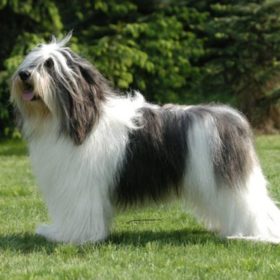 Polish Lowland Sheepdog
Polish Lowland Sheepdog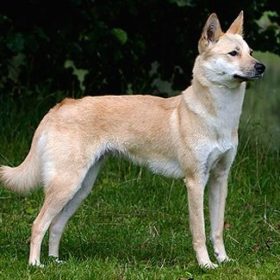 Korean Jindo
Korean Jindo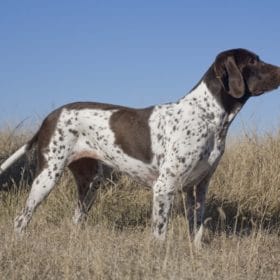 Old Danish Pointer
Old Danish Pointer Istrian Short-haired Hound
Istrian Short-haired Hound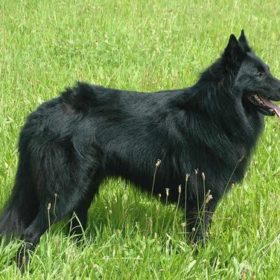 Belgian Shepherd Groenendael
Belgian Shepherd Groenendael Dandie Dinmont Terrier
Dandie Dinmont Terrier